Cyclone Idai: A Detailed Analysis of the Devastating Cyclone in Africa
VerifiedAdded on 2022/11/23
|5
|1139
|398
Essay
AI Summary
This essay examines Cyclone Idai, a strong category 2 storm that struck Southern Africa in March 2019, impacting Mozambique, Malawi, Madagascar, and Zimbabwe. The essay details the cyclone's formation, path, and destructive force, which caused over 1,200 deaths and widespread displacement. It explores the short-term effects, such as infrastructural damage, power outages, and communication shutdowns, as well as long-term consequences, including health problems, population redistribution, and economic strain. The analysis delves into the cyclone's impact on physical geography, including climate change and soil degradation, and its effects on the affected countries' political, economic, and social landscapes. The author offers a personal opinion on the event, emphasizing the importance of disaster preparedness and environmental conservation. The essay concludes by highlighting the need for increased efforts in disaster management and prevention, as well as adherence to environmental conservation to mitigate the risks of such disasters in the future.
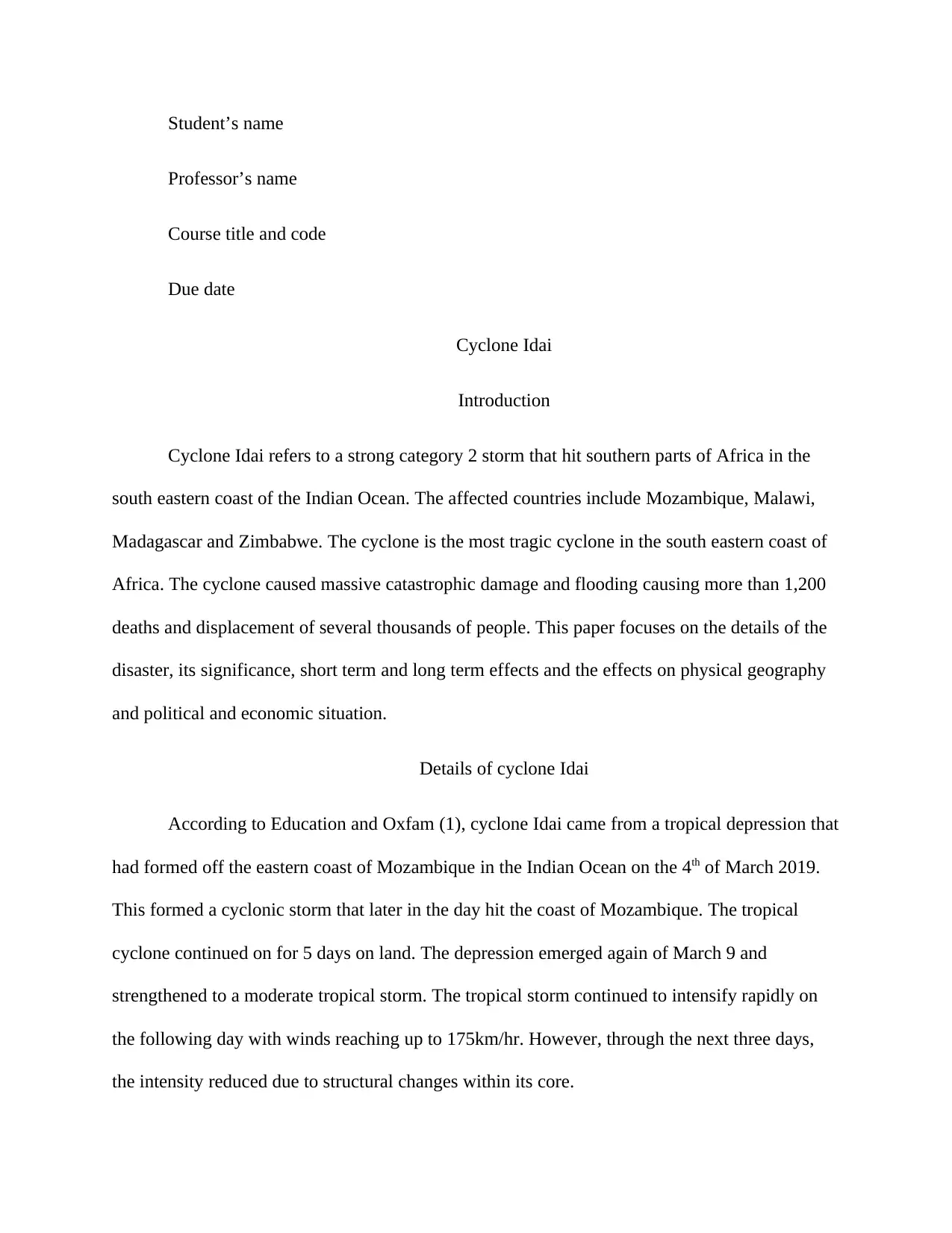
Student’s name
Professor’s name
Course title and code
Due date
Cyclone Idai
Introduction
Cyclone Idai refers to a strong category 2 storm that hit southern parts of Africa in the
south eastern coast of the Indian Ocean. The affected countries include Mozambique, Malawi,
Madagascar and Zimbabwe. The cyclone is the most tragic cyclone in the south eastern coast of
Africa. The cyclone caused massive catastrophic damage and flooding causing more than 1,200
deaths and displacement of several thousands of people. This paper focuses on the details of the
disaster, its significance, short term and long term effects and the effects on physical geography
and political and economic situation.
Details of cyclone Idai
According to Education and Oxfam (1), cyclone Idai came from a tropical depression that
had formed off the eastern coast of Mozambique in the Indian Ocean on the 4th of March 2019.
This formed a cyclonic storm that later in the day hit the coast of Mozambique. The tropical
cyclone continued on for 5 days on land. The depression emerged again of March 9 and
strengthened to a moderate tropical storm. The tropical storm continued to intensify rapidly on
the following day with winds reaching up to 175km/hr. However, through the next three days,
the intensity reduced due to structural changes within its core.
Professor’s name
Course title and code
Due date
Cyclone Idai
Introduction
Cyclone Idai refers to a strong category 2 storm that hit southern parts of Africa in the
south eastern coast of the Indian Ocean. The affected countries include Mozambique, Malawi,
Madagascar and Zimbabwe. The cyclone is the most tragic cyclone in the south eastern coast of
Africa. The cyclone caused massive catastrophic damage and flooding causing more than 1,200
deaths and displacement of several thousands of people. This paper focuses on the details of the
disaster, its significance, short term and long term effects and the effects on physical geography
and political and economic situation.
Details of cyclone Idai
According to Education and Oxfam (1), cyclone Idai came from a tropical depression that
had formed off the eastern coast of Mozambique in the Indian Ocean on the 4th of March 2019.
This formed a cyclonic storm that later in the day hit the coast of Mozambique. The tropical
cyclone continued on for 5 days on land. The depression emerged again of March 9 and
strengthened to a moderate tropical storm. The tropical storm continued to intensify rapidly on
the following day with winds reaching up to 175km/hr. However, through the next three days,
the intensity reduced due to structural changes within its core.
Paraphrase This Document
Need a fresh take? Get an instant paraphrase of this document with our AI Paraphraser
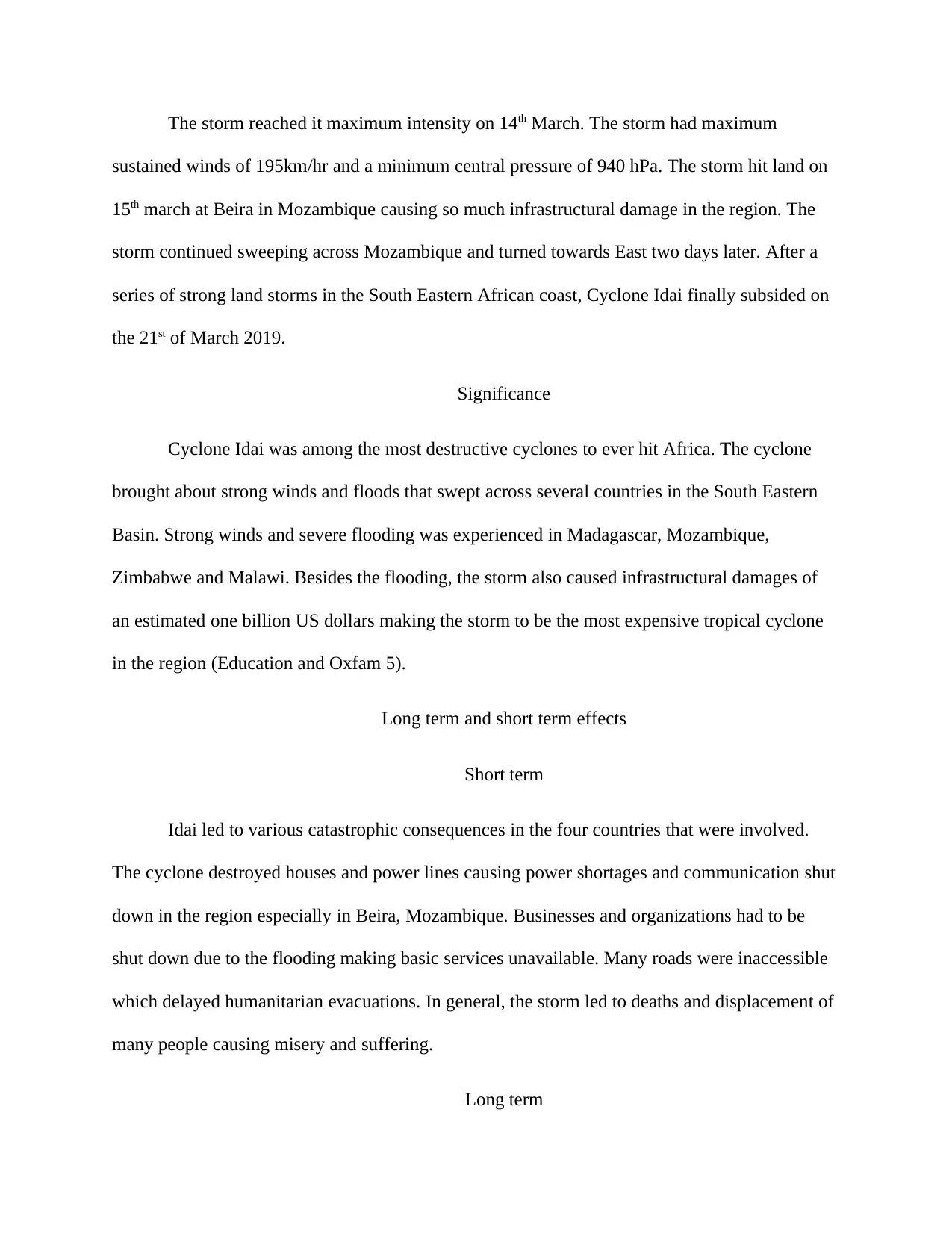
The storm reached it maximum intensity on 14th March. The storm had maximum
sustained winds of 195km/hr and a minimum central pressure of 940 hPa. The storm hit land on
15th march at Beira in Mozambique causing so much infrastructural damage in the region. The
storm continued sweeping across Mozambique and turned towards East two days later. After a
series of strong land storms in the South Eastern African coast, Cyclone Idai finally subsided on
the 21st of March 2019.
Significance
Cyclone Idai was among the most destructive cyclones to ever hit Africa. The cyclone
brought about strong winds and floods that swept across several countries in the South Eastern
Basin. Strong winds and severe flooding was experienced in Madagascar, Mozambique,
Zimbabwe and Malawi. Besides the flooding, the storm also caused infrastructural damages of
an estimated one billion US dollars making the storm to be the most expensive tropical cyclone
in the region (Education and Oxfam 5).
Long term and short term effects
Short term
Idai led to various catastrophic consequences in the four countries that were involved.
The cyclone destroyed houses and power lines causing power shortages and communication shut
down in the region especially in Beira, Mozambique. Businesses and organizations had to be
shut down due to the flooding making basic services unavailable. Many roads were inaccessible
which delayed humanitarian evacuations. In general, the storm led to deaths and displacement of
many people causing misery and suffering.
Long term
sustained winds of 195km/hr and a minimum central pressure of 940 hPa. The storm hit land on
15th march at Beira in Mozambique causing so much infrastructural damage in the region. The
storm continued sweeping across Mozambique and turned towards East two days later. After a
series of strong land storms in the South Eastern African coast, Cyclone Idai finally subsided on
the 21st of March 2019.
Significance
Cyclone Idai was among the most destructive cyclones to ever hit Africa. The cyclone
brought about strong winds and floods that swept across several countries in the South Eastern
Basin. Strong winds and severe flooding was experienced in Madagascar, Mozambique,
Zimbabwe and Malawi. Besides the flooding, the storm also caused infrastructural damages of
an estimated one billion US dollars making the storm to be the most expensive tropical cyclone
in the region (Education and Oxfam 5).
Long term and short term effects
Short term
Idai led to various catastrophic consequences in the four countries that were involved.
The cyclone destroyed houses and power lines causing power shortages and communication shut
down in the region especially in Beira, Mozambique. Businesses and organizations had to be
shut down due to the flooding making basic services unavailable. Many roads were inaccessible
which delayed humanitarian evacuations. In general, the storm led to deaths and displacement of
many people causing misery and suffering.
Long term
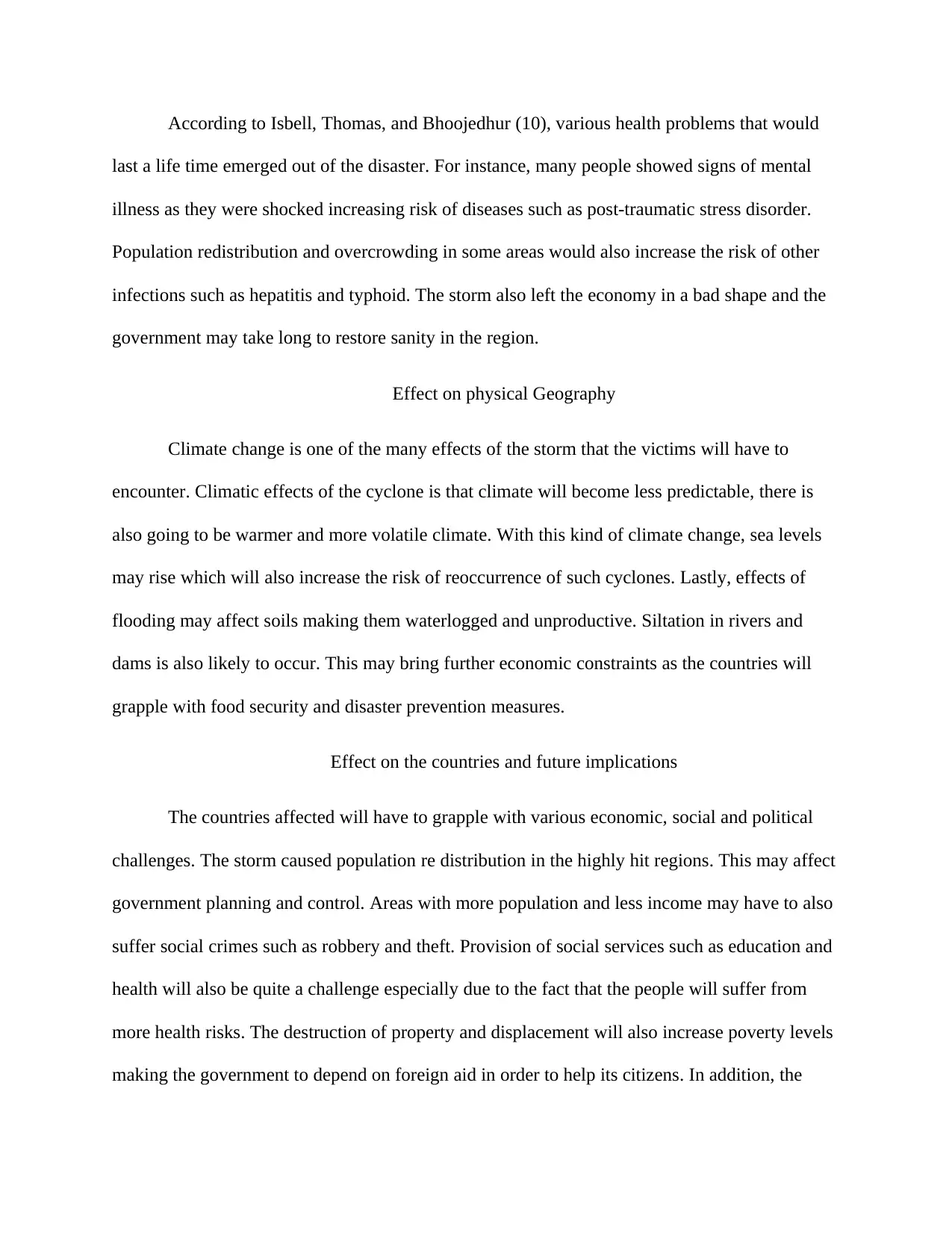
According to Isbell, Thomas, and Bhoojedhur (10), various health problems that would
last a life time emerged out of the disaster. For instance, many people showed signs of mental
illness as they were shocked increasing risk of diseases such as post-traumatic stress disorder.
Population redistribution and overcrowding in some areas would also increase the risk of other
infections such as hepatitis and typhoid. The storm also left the economy in a bad shape and the
government may take long to restore sanity in the region.
Effect on physical Geography
Climate change is one of the many effects of the storm that the victims will have to
encounter. Climatic effects of the cyclone is that climate will become less predictable, there is
also going to be warmer and more volatile climate. With this kind of climate change, sea levels
may rise which will also increase the risk of reoccurrence of such cyclones. Lastly, effects of
flooding may affect soils making them waterlogged and unproductive. Siltation in rivers and
dams is also likely to occur. This may bring further economic constraints as the countries will
grapple with food security and disaster prevention measures.
Effect on the countries and future implications
The countries affected will have to grapple with various economic, social and political
challenges. The storm caused population re distribution in the highly hit regions. This may affect
government planning and control. Areas with more population and less income may have to also
suffer social crimes such as robbery and theft. Provision of social services such as education and
health will also be quite a challenge especially due to the fact that the people will suffer from
more health risks. The destruction of property and displacement will also increase poverty levels
making the government to depend on foreign aid in order to help its citizens. In addition, the
last a life time emerged out of the disaster. For instance, many people showed signs of mental
illness as they were shocked increasing risk of diseases such as post-traumatic stress disorder.
Population redistribution and overcrowding in some areas would also increase the risk of other
infections such as hepatitis and typhoid. The storm also left the economy in a bad shape and the
government may take long to restore sanity in the region.
Effect on physical Geography
Climate change is one of the many effects of the storm that the victims will have to
encounter. Climatic effects of the cyclone is that climate will become less predictable, there is
also going to be warmer and more volatile climate. With this kind of climate change, sea levels
may rise which will also increase the risk of reoccurrence of such cyclones. Lastly, effects of
flooding may affect soils making them waterlogged and unproductive. Siltation in rivers and
dams is also likely to occur. This may bring further economic constraints as the countries will
grapple with food security and disaster prevention measures.
Effect on the countries and future implications
The countries affected will have to grapple with various economic, social and political
challenges. The storm caused population re distribution in the highly hit regions. This may affect
government planning and control. Areas with more population and less income may have to also
suffer social crimes such as robbery and theft. Provision of social services such as education and
health will also be quite a challenge especially due to the fact that the people will suffer from
more health risks. The destruction of property and displacement will also increase poverty levels
making the government to depend on foreign aid in order to help its citizens. In addition, the
⊘ This is a preview!⊘
Do you want full access?
Subscribe today to unlock all pages.

Trusted by 1+ million students worldwide
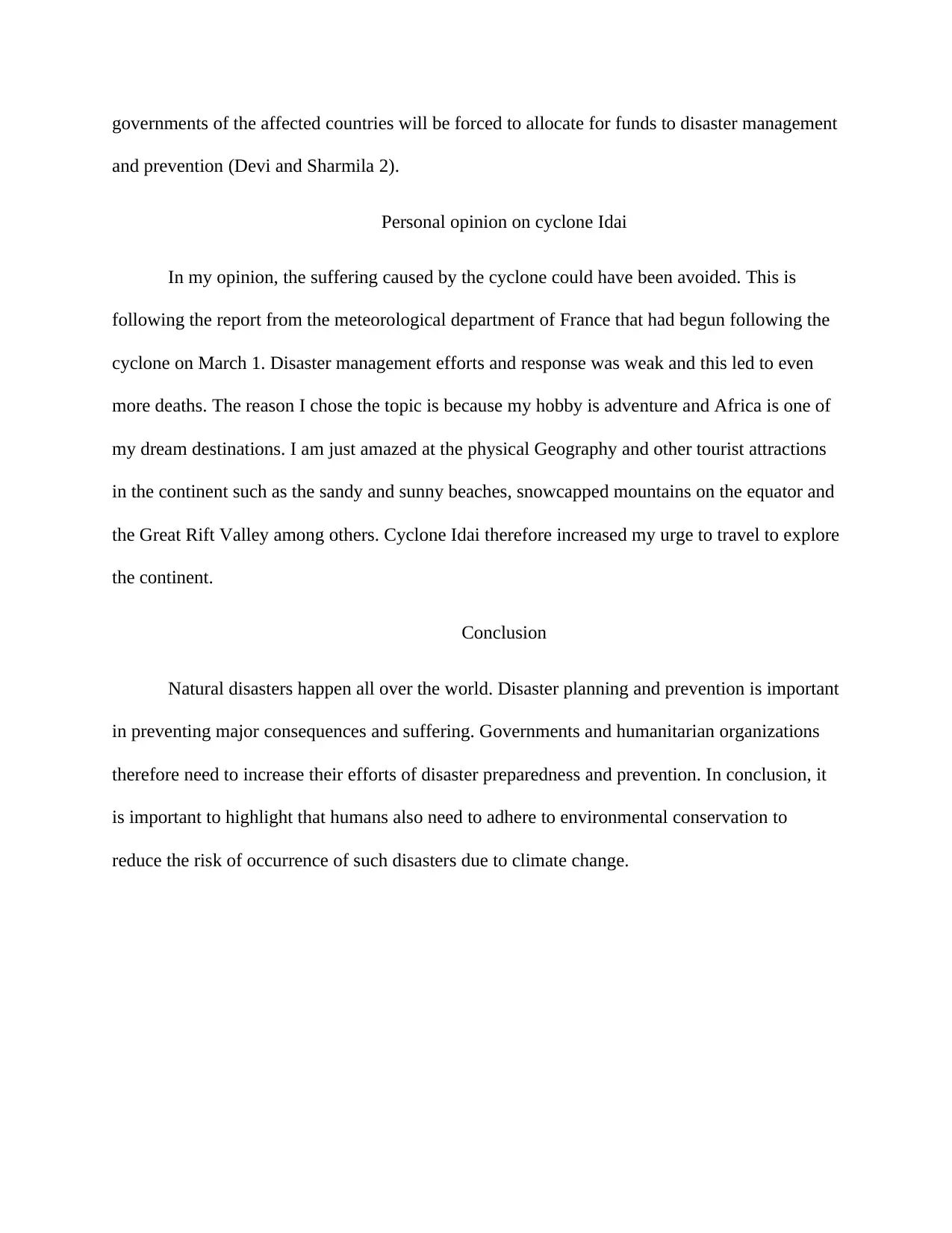
governments of the affected countries will be forced to allocate for funds to disaster management
and prevention (Devi and Sharmila 2).
Personal opinion on cyclone Idai
In my opinion, the suffering caused by the cyclone could have been avoided. This is
following the report from the meteorological department of France that had begun following the
cyclone on March 1. Disaster management efforts and response was weak and this led to even
more deaths. The reason I chose the topic is because my hobby is adventure and Africa is one of
my dream destinations. I am just amazed at the physical Geography and other tourist attractions
in the continent such as the sandy and sunny beaches, snowcapped mountains on the equator and
the Great Rift Valley among others. Cyclone Idai therefore increased my urge to travel to explore
the continent.
Conclusion
Natural disasters happen all over the world. Disaster planning and prevention is important
in preventing major consequences and suffering. Governments and humanitarian organizations
therefore need to increase their efforts of disaster preparedness and prevention. In conclusion, it
is important to highlight that humans also need to adhere to environmental conservation to
reduce the risk of occurrence of such disasters due to climate change.
and prevention (Devi and Sharmila 2).
Personal opinion on cyclone Idai
In my opinion, the suffering caused by the cyclone could have been avoided. This is
following the report from the meteorological department of France that had begun following the
cyclone on March 1. Disaster management efforts and response was weak and this led to even
more deaths. The reason I chose the topic is because my hobby is adventure and Africa is one of
my dream destinations. I am just amazed at the physical Geography and other tourist attractions
in the continent such as the sandy and sunny beaches, snowcapped mountains on the equator and
the Great Rift Valley among others. Cyclone Idai therefore increased my urge to travel to explore
the continent.
Conclusion
Natural disasters happen all over the world. Disaster planning and prevention is important
in preventing major consequences and suffering. Governments and humanitarian organizations
therefore need to increase their efforts of disaster preparedness and prevention. In conclusion, it
is important to highlight that humans also need to adhere to environmental conservation to
reduce the risk of occurrence of such disasters due to climate change.
Paraphrase This Document
Need a fresh take? Get an instant paraphrase of this document with our AI Paraphraser
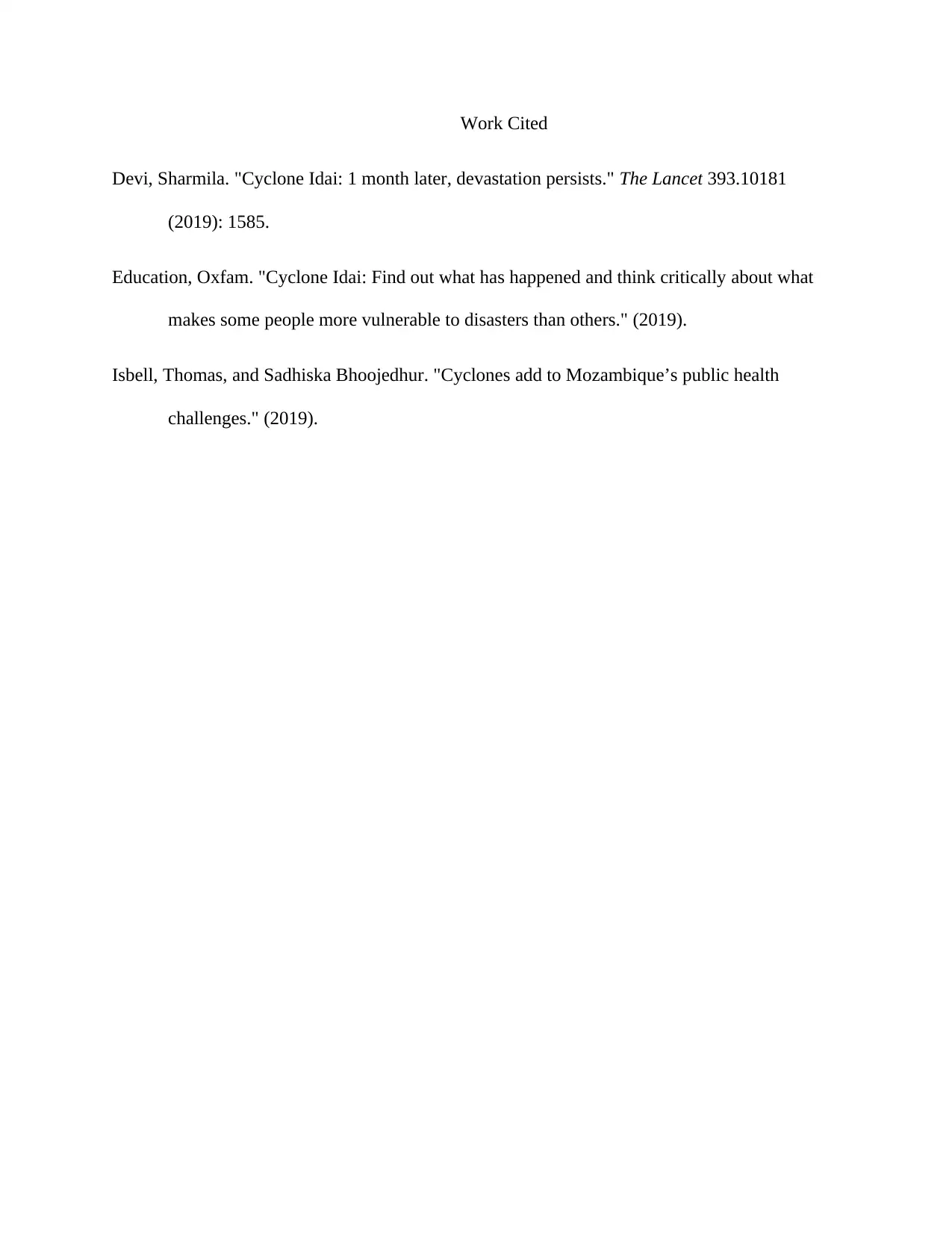
Work Cited
Devi, Sharmila. "Cyclone Idai: 1 month later, devastation persists." The Lancet 393.10181
(2019): 1585.
Education, Oxfam. "Cyclone Idai: Find out what has happened and think critically about what
makes some people more vulnerable to disasters than others." (2019).
Isbell, Thomas, and Sadhiska Bhoojedhur. "Cyclones add to Mozambique’s public health
challenges." (2019).
Devi, Sharmila. "Cyclone Idai: 1 month later, devastation persists." The Lancet 393.10181
(2019): 1585.
Education, Oxfam. "Cyclone Idai: Find out what has happened and think critically about what
makes some people more vulnerable to disasters than others." (2019).
Isbell, Thomas, and Sadhiska Bhoojedhur. "Cyclones add to Mozambique’s public health
challenges." (2019).
1 out of 5
Your All-in-One AI-Powered Toolkit for Academic Success.
+13062052269
info@desklib.com
Available 24*7 on WhatsApp / Email
![[object Object]](/_next/static/media/star-bottom.7253800d.svg)
Unlock your academic potential
Copyright © 2020–2025 A2Z Services. All Rights Reserved. Developed and managed by ZUCOL.
